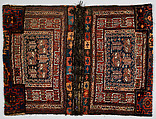Double Flour Bag
Not on view
Double flour bags, which were carried on the backs of pack animals, are distinctive for their large size. Examples created by Bakhtiari weavers almost always include both tightly woven sumak extra-weft wrapping and reinforcement over points of extreme wear in the form of pile weave, typically with symmetrical knots. These methods would prevent flour from sifting through the bag.
The closure of this bag was made with a tapestry (kilim) technique, with slits on one side and braided loops on the other. A band of twining, which extends into the three-dimensional loops, is worked into the plain-weave structure of the back of the bag, creating a stronger, more durable construction.
Due to rights restrictions, this image cannot be enlarged, viewed at full screen, or downloaded.
This artwork is meant to be viewed from right to left. Scroll left to view more.



